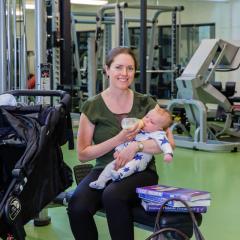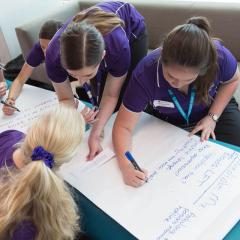Johnny, a 10 year old from the Western Queensland town of Tara was struggling with his classroom learning and social communication with his class mates.
It was identified by Queensland Education Speech Pathology Services that his speech and language issues were significant contributors to his learning and communication difficulties and speech pathology would be beneficial. However, living in Tara, where speech pathology services are limited, if he were to travel to the nearest face to face sessions, a full day for a one hour appointment could have been required.
Using telerehabilitation, Johnny was able to receive tailored pediatric speech pathology sessions in the comfort of his own school. He was among nine Tara State Shire College (TSSC) students from prep to year four who received the speech pathology service offered by UQ Speech Pathology students as part of their final year clinical placement.
This effective method of service delivery was provided from UQ’s Telerehabilitation Clinic (TRC), among the first in Australia and the world.
Made possible by a $500,000 donation from the Bowness Family Foundation, the TRC is headed by Professor Deborah Theodoros and Professor Trevor Russell.
Using sound, video clips and photos on an iPad, as well as toys, puppet characters, background sets and props the speech pathology students each provided a tailored session that was required to engage the TSSC students. UQ Speech Pathology graduate, Emma Grieg looked after Johnny as part of her final year clinical placement.
“It was such a rewarding experience working with Johnny, especially as he responded so positively to the technology in my sessions,” Emma says.
“Interacting via the iPad seemed to be less threatening or demanding than a face-to-face session for him. He was able to focus his attention and learn very effectively during the sessions. This positive response was something that had not been seen by his teacher in the regular classroom.”
As the sessions were conducted from UQ’s Telerehabilitation Clinic in Brisbane to the primary school students over 300 kilometers away using telecommunication, it was a challenge for the UQ students requiring them to learn new skills quickly, beyond what is typically expected of a fourth-year student.
“I found this aspect of the placement rewarding, as I was able to contribute to the advancement of telerehabilitation services for UQ and the wider speech pathology and allied health communities. I enjoyed observing the improvements in my client’s communication skills and especially that these improvements also generalised to the classroom and home environments,” she says.
Speech Pathology Clinical Educator Judy Tait who was responsible for the learning of the student clinicians was extremely happy with the quality of the services provided to the primary school students.
“It was great to see the enthusiasm and hard work of the student clinicians and this was exemplified by the great results we achieved for the children at TSSC,” Judy says.
“The placement required students to apply their specialist speech pathology knowledge and skills in the context of telepractice. In the process, they gained many new skills.”
“One challenge the students faced was learning to look into the webcam rather than at the client’s face on the screen. If the student clinician didn’t look into the camera, the client on the other end would not have the sense that they were in eye contact.”
“The students have done something that is quite ‘out of the ordinary’ for a final semester student placement. This unique placement will make their job applications stand out from the crowd, as telerehabilitation will be a major part of speech pathology practice in the future.”
Speech Pathology graduate Emma believes that the placement broadened her perception of speech pathology as a profession.
“I was required to use lots of creativity to adapt to this service delivery model, so I developed new ways of thinking about how to do assessment and intervention in ways that are engaging for the children,” she says.
“There are many techniques I learnt via telerehabilitation that I will now use in face-to-face service delivery. Completing the project as my clinical placement has inspired me to seek other research and quality improvement projects in the future.”
From the primary school students’, UQ students’ and clinical educators’ positive reports and results it is clear the first service offered by UQ’s Telerehabilitation Clinic was an exceptional success.
“To be able to provide a service to children who, without this program, may not have received the speech pathology they required, has made me feel like I was making a significant difference in their lives,” Emma says.
To find out more about the Telerehabilitation Clinic services offered call 07 3365 2232 or visit the website.
The Telerehabilitation Clinic was made possible in part by a $500,000 philanthropic grant by The Bowness Family Foundation. The speech pathology program offered to the TSSC is one of the services the Health-e-Regions project provides to the Western Downs towns of Dalby, Chinchilla, Miles, Tara and Wandoan. The project is a whole of community model for providing health services. Natural gas company QGC, has supported this telehealth project in the regions since 2012. Their recent commitment for a further two years makes for a total of over $2.7 million in contributions to the Health-e-Region’s project, demonstrating their commitment to social responsibility in the Western Downs.
Words: Kirsten O'Leary



